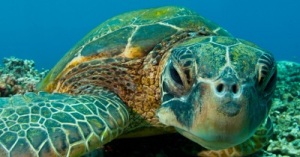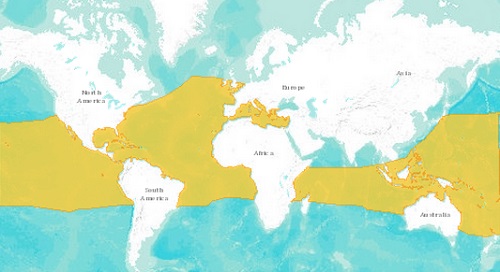0
Taxonomy

Green Sea Turtle (chelonia mydas) at the New England Aquarium. The IUCN Red List of Threatened Species classifies the green see turtle as an endangered species.
- Family: Animalia
- Phylum: Chordata
- Class: Reptilia
- Order: Testudines
- Family: Cheloniidae
- Genus: Chelonia
- Species: Chelonia mydas
0
Name
- Scientific name: Chelonia mydas
- Common name: Green turtle, green sea turtle, black sea turtle.
Habitat and Distribution
- Its habitat extends throughout tropical and subtropical seas. They stay along the coast and islands between 30 degrees north and 30 degrees south. They rarely adventure to the open ocean.
- The largest nesting grounds of green turtles are located in Tortuguero in Costa Rica and Raine Island in Australia.
- In the U.S. their primary nesting ground is located in the central and south coast of Florida.
- Adult green sea turtles prefer to live near sea grass beds, mangroves and coral reefs while younger ones live farther from shore.

Green sea turtles live in tropical and subtropical waters. Source: IUCN Red List of Threatened Species.
Physical Features
- The green turtle gets its name from a layer of green fat under its carapace and not from the color of its shell.
- They have a smooth shell called carapace in the shape of a tear drop. They can be different shades of black, gray, brown, yellow or green. The bottom of their shell is called plastron and it is yellow.
- The carapace changes color over time. Hatchings have black carapace.
- They have the largest carapace of all turtles.
- Their limbs are dark colored and lined in yellow.
- They have paddle-like arms adapted for swimming.
- Their snout is short and its beak unhooked.
- Green turtles have small heads relative to the size of their bodies.
Size and length
- On average the green turtle measures up to 5 f or 1.5 m long.
- Their weight fluctuates from 150 lb or 68 kg to 419 lb or 190 kg.
- The length of its carapace can be from 31 in or 78 cm to 44 in or 112 cm.
- The largest known green turtle weighed 871 lb or 395 kg.
Diet
- Adult green turtles are herbivorous they feed from algae and sea grass. They are the only species of herbivorous marine turtles.
- Younger green turtles have an herbivorous and carnivorous diet.
Migration and breeding
- Green turtles migrate long distances between feeding sites and breeding and nesting grounds. They swim more than 1,600 m or 2,600 km.
- It is believed that green turtles reach sexual maturity between 20 to 50 years of age.
- Adult females return to the beach where they were hatched every 2 to 4 years, while males return every year in order to mate.
- Females dig a hole in the sandy beach where she lays her eggs. She covers them with sand and returns to the sea.
- They nest between 3 to 5 times per season laying between 70 and 100 eggs.
- Incubation lasts from 50 to 70 days.
- After hatchings are born they go to the water where they have to face their predators. Hatchings are 2 in or 50mm long and weigh about 0.05 lb or 25 gr.
Life Expectancy
- Green sea turtles can live an average of 80 years in the wild.
Threats
- Green sea turtles suffer from fibropapillomatosis which is a debilitating tumor growth.
- Degradation of nesting beaches.
- Sea pollution, plastic bags, oil, marinas and vessel traffic.
- Overharvesting of eggs and adult turtles for their meet.
Conservation Status
- The IUCN Red List considers the population of chelonia mydas as “endangered”.
Did you know?
A group of sea turtles is called “bale”.
References and further research
National Oceanic and Atmospheric Organization
